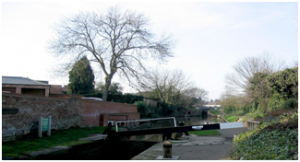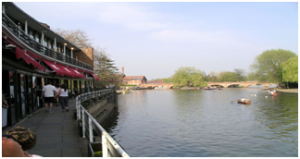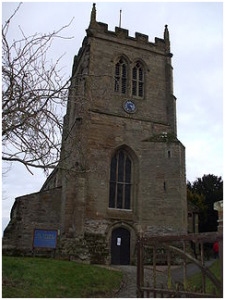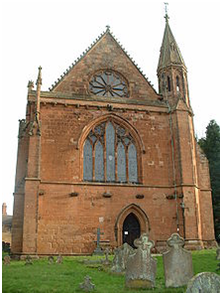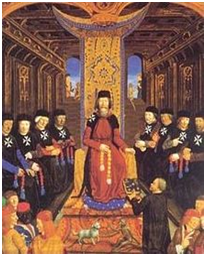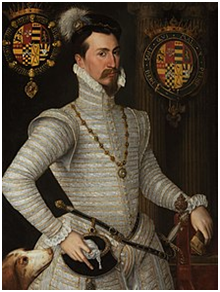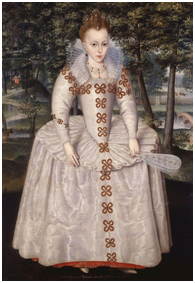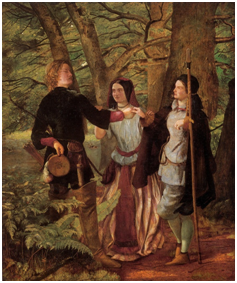(七)
但凡莎仙之类的凤毛麟角,之所以受到“前无古人后无来者”等各式各样的天地之忽悠,无不因为他/她食尽人间烟火,才达到蚁群鼠辈都趋之若鹜…却遥不可及的顺风顺水顺境。另外,再说一句本末倒置的醉话:假如没有埃德加·艾伦·坡(American writer Edgar Allan Poe)及其贡献给人类的那只恐怖诡异空灵的《乌鸦》,埃文河畔的白天鹅们,大概早就乏味可呈,无趣退场了:
从前一个阴郁的子夜,我独自沉思,慵懒疲竭,
面对许多古怪而离奇、并早已被人遗忘的书卷;
当我开始打盹,几乎入睡,突然传来一阵轻擂,
仿佛有人在轻轻叩击——敲我房间的门环。
“有客来也”,我轻声嘟喃,
“惟此而已,别无他般。”
哦,我清楚地记得那是在风凄雨冷的十二月,
团团奄奄一息的余烬都形成阴影伏在地板。
我当时真盼望明天——因为我已经枉费心机,
想用书来消除伤悲,拂去因失去丽诺尔的痛感,
因那被天使叫作丽诺尔的少女,她美丽娇艳;
如今芳踪早已不在,直至永远。
我转身回到房间,整个心胸灼烧堵塞,
很快我又听到叩击声,比刚才听起来更加真切。
“肯定”,我说,“肯定有什么在我的窗户外面;
让我去瞧瞧到底是啥玩意儿,把那秘密给发现。
且定定神先冷静一会儿,再去弄他个水落石出;
那不过是空穴来风,别无他般!”
然后我推开窗棂,随着翅膀的一阵猛扑,
有只神圣往昔的乌鸦庄重地飞入进帘;
它既没向我问候致意,也没片刻停下,
而是温文尔雅风度翩翩挪到房门上端,
接着栖息在一尊帕拉斯半身雕像上面;
笃笃定定,仅如此这般。
于是这只黑鸟把我悲伤的幻觉哄骗成微笑,
以它那端庄老成一本正经的儒雅姿态;
“冠毛虽被剪除”,我说,“但你显然不是懦夫,
你这幽灵般可怕的古鸦,漂泊来自夜的彼岸,
请教贵客尊姓大名,在黑沉沉的冥府阴间!”
乌鸦答曰–“永不复焉”。
听见如此直率的回答,我对这丑鸟感到惊讶,
尽管回答不着边际——与提问几乎毫不搭嘎;
因为我们不得不承认,从来没有活着的世人
曾如此有幸看见鸟儿大摇大摆来到他的房间;
并堂而皇之停留在一蹲半身雕像上面,
而且口口声声自称“永不复焉”。
但那只栖于肃穆的半身雕像上的乌鸦只说了
这一句话,仿佛它倾泻灵魂就用那一个字眼。
然后它便一声不吭——也不颤动一下它的羽毛,
直到我几乎喃喃自语,“一厢情愿宴席已散,
明晨它也将离我远去,如同现在万灰俱灭。”
这时乌鸦又说–“永不复焉”。
寂静被完璧无瑕之语打破使我惊愕不已,
“肯定”,我说,“此话是它仅会说的人言,
从它不幸的主人口中学来。一连串横祸飞灾
曾接踵而至,直到它主人的呜咽中有了这字眼,
直到他希望的挽歌中有了这句忧郁的叹息——
永不复焉,永不复焉。”
但那只乌鸦仍然在骗我悲伤的灵魂露出微笑,
我即刻拖了张软椅到门边雕像下注视它的跟前;
然后干脆坐在天鹅绒椅垫上开始浮想联翩,
绞尽脑汁揣测这不祥的古鸟何出此言,
这个狰狞丑陋可怕的凶兆究竟居心何在,
为何对我大言不惭“永不复焉”?
我坐着斟酌那意思,但没对乌鸦开口片语只言,
此时,它炯炯发光的眼睛已燃进冰冷的心坎;
我纹丝不动呆在那儿,把头靠得安逸舒坦。
置身于灯光凝视下的天鹅绒椅垫,
静静躺在紫色余温上面思念,
她还会靠么?啊,永不复焉!
《乌鸦》——埃德加·爱伦·坡
“The Raven” depicts a mysterious raven’s winter midnight visit to a distraught lover, as illustrated by John Tenniel (1858), tracing the man’s slow fall into madness. The mourning narrator, often identified as being a student, is lamenting the loss of his love, Lenore. Sitting on a bust of Pallas, the raven seems to further distress the protagonist with its constant repetition of the word “Nevermore“. Poe’s famous thought provocative poem makes use of folk, mythological, religious, and classical references. Edgar Allan Poe (January 19, 1809 – October 7, 1849) was an American writer, editor, and literary critic, best known for his poetry and short stories, particularly his tales of mystery and the macabre. He is widely regarded as a central figure of Romanticism in the United States and American literature as a whole, and he was one of the country’s earliest practitioners of the short story. The second child of two British actors immigrated to Boston, his father abandoned the family in 1810, and his mother died the following year, the orphaned child was taken in by John and Frances Allan of Richmond, Virginia. Later, Poe became the first well-known American writer to try to earn a living through writing alone, resulting in a financially difficult life and career.
沉舟侧畔千帆过,病树前头万木春;污泥浊水芙蓉媚,阿登森林梦里香。这几句信口呻吟,用在威廉·莎士比亚(William Shakespeare 1564-1616) 身上不算太离谱。莎文豪是英国文学史上最杰出的戏剧家及诗魂,也是欧洲文艺复兴时期无与伦比的经典作家,更是全球乃至千秋万代敬拜的永恒泰斗。华人文艺圈爱尊文圣为莎翁,也许因为实在不敢恭维清末民初鲁迅在《摩罗诗力说》(1908年2月)开先河的“狭斯丕尔”。
他出生于大不列颠联合王国的沃里克郡、埃文河畔、斯特拉特福小镇(Stratford-upon-Avon, Warwickshire)的一个小资市民家庭。莎家浜距离伦敦西北91英里(146公里),最初原是盎格鲁 – 撒克逊人(Anglo-Saxons)居住的一个小村庄,直到1196年库唐斯的庄园主约翰(the lord of the manor, John of Coutances)绘制蓝图开发过后,才变成袅娜多姿的皇家狩猎胜地。同年,理查德一世国王(King Richard I)奏章批示,兴起在镇上举办每周一次的集市贸易活动,因而吸引公子王孙来郊外嘻嘻哈哈陶冶情趣,奠定了远近闻名的集镇地位,并带动了活跃的商贸市井文化,逐渐扬起小桥流水人家式的卓越风采。 自此,斯特拉特福德欣欣向荣,蒸蒸日上。
A quiet stretch of the Stratford-upon-Avon Canal in Stratford-upon-Avon today, Warwickshire, England, including a lock gate in the foreground and another lock in the distance.
自古至今,风水宝地大同小异;莎家浜一如既往,天鹅戏水,仙气飘飘;各路骚客偕同商贩兴致勃勃,来来往往,更引无数才子佳人竞折腰。从前,埃文河(River Avon)畔人头攒动、络绎不绝、鸡犬相闻、吆喝鼎沸的清明河上图,大可跟同时代隔洋的龙帝国里金陵秦淮盛景异曲同韵,遥相呼应。这条楚楚动人的文静穆斯裙带,从英格兰东部妩媚穿过中央,婉约向西南潺潺流淌。斯特拉特福镇的这条自命不凡的埃文,明显不屑跟企图沾边的其她平庸河水(other Rivers Avon)同流合污。为了更加鲜明突出自己的别具一格和独到之处,她也与沃里克郡(Warwickshire Avon) 以及莎士比亚(Shakespeare’s Avon)芳名共享,雅致千秋。
View of the River Avon from the Royal Shakespeare Theatre;Stratford-upon-Avon is a popular tourist destination owing to its status as birthplace of English playwright and poet William Shakespeare, and receives approximately 2.5 million visitors a year. The Royal Shakespeare Company resides in Stratford’s Royal Shakespeare Theatre.
文豪出生地的好风好水有目共睹,不用多废口舌。下面,让我们再来细细考察哺育他的摇篮,看看其中是否真有啥奥妙。按我们一贯的家庭成分审视习惯,先从莎士比亚的母亲开始着手:
她叫玛丽·阿登( Mary Arden),来自埃文河畔极有身份的大户人家,在8朵阿登金花中,玛丽是最小的一枚,大概也是最受宠爱的公主。早在“诺曼征服英格兰”(Norman Conquest)之前,沃里克郡(Warwickshire)的阿登家族(Arden family)就已经相当杰出,祖上拥有一大批神通广大的宗室和社会关系。例如:托马斯·阿登(Thomas Arden)曾在“十三世纪的内战”(the thirteenth-century civil war)中,为蒙特福的西蒙和南爵们(Barons and Simon de Montfort)抛头颅洒热血;罗伯特·阿登(Robert Arden)参加过“玫瑰战争”( Wars of the Roses,1455 -1487),身经百战、久经沙场;约翰·阿登曾侍奉亨利七世国王宫庭(John Arden served on the court of King Henry VII)。还有,阿登家族中有些成员笃信天主教(Catholic faith)。

1908 painting by Henry Payne of the scene in the Temple Garden from Shakespeare‘s play Henry VI, Part 1, where supporters of the rival factions pick either red or white roses. The painting is William Shakespeare‘s version of the splitting of nobles into the factions of York and Lancaster, sparking the Wars of the Roses in 15th-century England. Richard Plantagenet, 3rd Duke of York and his followers select the white rose, while the Duke of Somerset and his sole companion took the red. The final victory went to a relative and claimant of the Lancastrian party, Henry Tudor, Earl of Richmond, who defeated Richard III at the Battle of Bosworth Field. After assuming the throne as Henry VII, he married Elizabeth of York, the eldest daughter and heir of Edward IV, thereby uniting the two claims. The House of Tudor ruled the Kingdom of England until 1603, with the death of Elizabeth I, granddaughter of Henry VII and Elizabeth of York.
玛丽的父家位于埃文河宠幸的“沃里克郡”(Warwickshire);据县志记载,1561年,此处是豪绅占据的一片“雄伟威尔姆寇特乡村别墅”(the manor of Great Wilmcote),包括玛丽·阿登(Mary Arden)家在“威尔姆寇特村”(Wilmcote)的祖宅,以及“私奈特菲尔德村”(Snitterfield)的田地。威村(Wilmcote)离“斯特拉特福镇”(Stratford-upon-Avon)以北约3英里(5公里);较偏远一些的私村(Snitterfield)阿登良田,离镇上也只有4.5英里(7.2公里)。
St James the Great, Snitterfield. Snitterfield is a village and civil parish in the Stratford on Avon district of Warwickshire, 4.5 miles (7.2 km) from Stratford upon Avon.
早在诺曼征服英格兰(Norman conquest of England)的时候,私村(Snitefeld)一带被萨克西(Saxi)霸占,该主也拥有沃尔顿(Walton)和查理寇特(Charlecote)等附近多个村落的土地;但到了1086年,豪绅改成墨兰伯爵(Count of Meulan)。 起初,地名Snitterfield的拼写法是 Snytenfeld,意思是“开阔的鹬场” ( open field of snipe): Feld代表“阿登森林” (Forest of Arden)包围之中的一望无际的田野,而Snyten指经常光临的长尖嘴鹬(snipe),鸟儿们最爱在穿过村庄的“舍伯恩溪流”(Sherborne Brook)的附近草地里叽叽喳喳。
The pin-tailed snipe or pintail snipe (Gallinago stenura) is a species of bird in the family Scolopacidae, the sandpipers.
来龙去脉又一番之后,迷雾缭绕的莎家浜若隐若现。按照英格兰(England)的传统地理划分,沃里克郡(Warwickshire)内,从埃文河(River Avon)延伸到泰姆河(River Tame)的整个这片,都叫“阿登地区”(Arden area);它不仅涵盖了今天沃里克县(county of Warwick)西北部的大半块,也触及斯塔夫德郡(Staffordshire)和伍斯特郡(Worcestershire)部分领土,南至埃文河畔斯特拉特福镇(Stratford-on-Avon),北搭斯塔福德郡内的塔姆沃思市 (Tamworth in Staffordshire),包括伯明翰(Birmingham)和考文垂(Coventry)等几大城市。这一带原始草木密集茂盛,参天大树盖天蔽日,风声鹤唳飞禽走兽,因此得名黑黢黢的“阿登森林” (Forest of Arden)。然而,本地似乎不受任何“森林法”(forest law)的约束和限制;至今,依然以林地为主的乡野人烟稀少,仍保持500年前稻花香村固有的原汁原味和古色古香。
The Forest of Arden (1888 – 1897, possibly reworked 1908), Albert Pinkham Ryder. Oil on canvas, Metropolitan Museum of Art, New York City. Arden is an area, located mainly in Warwickshire, England, and also part of Staffordshire and Worcestershire traditionally regarded as extending from the River Avon to the River Tame. It was once heavily wooded, giving rise to the name ‘Forest of Arden’. It does not seem that the area was subject to forest law however.
毋庸置疑,浪漫气息经久散发的“阿登原始森林”,迷惑了不知多少梦痴情圣,特地选在仲夏夜身临其境,流连忘返。在距离伯明翰(Birmingham)东南约15英里的“阿泥河谷”(valley of the River Alne)里, 发现一处叫“阿登境内的邯磊镇” (Henley-in-Arden)的铁器时代山堡遗址(the site of an Iron Age hillfort),经考古学家鉴定,认为是古代极其重要也是当地最大的一个定居点。大约1162年至1312年,“圣殿骑士” (Knights Templar) 教会在“阿登森林”(Forest of Arden)的腹地上,拥有一座被称为“包尔梢寺”( Temple Balsall)的圣道活动会所;以此庙为中心,12世纪发展成了该组织在英格兰中西部沃里克郡的一个主要社区。居住于此的众圣徒们志同道合,相依为命;勤劳智慧的兄弟们互帮互助,携手经营治理家园,在大约650英亩 (2.6 km2) 的土地上放牧养殖开垦耕作,逐步建立起“包尔梢庄园”(Balsall Preceptory),使之成为“圣殿骑士”机构的母舰。
St Mary’s Church, Temple Balsall, is a parish church in the Church of England. It is a small hamlet within the Metropolitan Borough of Solihull in the English West Midlands, situated between the large villages of Knowle and Balsall Common. Formerly in Warwickshire, the church was built by the Knights Templar and is the Mother Church of the Templars and the Knight Hospitallers. Knights of both Orders are illustrated in the Altar window.
1307年10月13日,那个漆黑的星期五黎明,法国国王菲利普四世(King Philip IV)下令:同时捉拿本国“圣殿骑士”宗师雅克·德莫莱长老(the elderly Grand Master Jacques de Molay)及其他数十名法国圣殿军师(French Templars),造就了七百年来“13点兮兮” 的“黑色星期五”凶兆迷信(the Friday the 13th superstition)。逮捕令开头说:“上帝不悦,吾国信仰有敌。” ["God is not pleased. We have enemies of the faith in the kingdom. "] 有人声称,在圣堂入教仪式期间,新征门徒被迫往十字架上吐唾沫,否认基督,并进行猥亵接吻; 圣殿弟兄们也被指控崇拜偶像(worshipping idols or idolatry),并有同性恋之类的龌龊行为,还涉嫌金融腐败、欺诈要挟和阴暗私秘等种种奇耻大辱。许多被告在酷刑与胁迫下(under duress)不得不招认,导致巴黎掀起丑闻的阵阵热浪。结果,骑士们从至高的圣殿山(Temple Mount)坠落万丈深渊,再也没能从地狱里爬出来。
随后,克莱门特教皇( Pope Clement)屈从于菲利普的要求,于1307年11月22日发布“教皇公牛”(papal bull Pastoralis Praeeminentiae),指示欧洲的所有基督教君主,将他们地盘上的圣殿骑士全都一网打尽,并扣押没收他们的资产。接下来,克莱门特教皇召开了几次听证会,以断定圣殿骑士有罪还是无辜,并曾一度放松和免除审查酷刑(Inquisitors‘ torture),许多圣殿骑士乘机撤回了他们身不由己的坦白交代。虽然被告中的一些人有足够的法律经验当堂为自己有效辩护,但1310年,存心要把骑士们赶尽杀绝的法兰西菲利普国王,任命参议院的大主教菲利普·德马里尼(the archbishop of Sens, Philippe de Marigny)主持调查后,利用先前的逼供,将几十个圣殿骑士绑上了火刑柱,让他们在巴黎市民的诅咒唾弃中活活烧成灰烬,圣殿骑士伸张正义的愿望就被彻底阻止了。
在菲利普的武力要挟下,无奈的教皇克莱门特只得顺从歹毒意愿,同意解散“圣殿教派”,并引用了原先供词所制造的公开丑闻。在1312年的“维也纳会议”(Council of Vienne)上,他发布了一系列教皇谕旨,其中,Vox in excelso正式解除“圣殿教会”,Ad providam命令将大部分圣殿资产移交给“骑士团体”(Hospitallers)。至于雅克·德莫莱宗师(Grand Master Jacques de Molay)和杰弗罗伊·德·查尼(Geoffroi de Charney, Preceptor of Normandy)等圣殿领导,纷纷撤回之前的供词并坚持自己的清白,但俩人都被判成是死不改悔、一犯再犯的邪教重犯(relapsed heretics),于1314年3月18日在巴黎街头被判处火刑,殉教献身。
传说,德莫莱(De Molay)临终前大义凛然,要求让他面对巴黎圣母院(Notre Dame Cathedral)并能双手合十祈祷的五花大绑服刑。当熊熊烈火吞噬他时,仍传出德莫莱铿锵有力的谴责,诅咒克莱门特教皇(Pope Clement)和菲利普国王(King Philip)很快就会在上帝面前与他相见!后来,德莫莱从火焰中发出的吼声被转录到羊皮纸上,存档遗留下来: “上帝知道孰错孰非,灾难很快就会临到判我们死罪的那些人的头上了。”(“God knows who is wrong and has sinned. Soon a calamity will occur to those who have condemned us to death.”) 果不出所料,仅在一个月之后,克莱门特教皇魂归西天,菲利普国王也在当年年底的一次狩猎事故中一命呜呼。
随着圣殿组织的最后一批头目遭到清算,整个欧洲对剩下的圣殿骑士要么穷追猛打,捉拿归案;要么在教庭调查审判以后,酌情处理,安排“骑士军团”(Knights Hospitaller)之类的其他御佣十字军机构吸收圣殿残余;或来个顺水推舟,让不中用的告老还乡,静享天年,安度余生。根据教皇的公牛法令,属于圣殿派的财产一律转交给“骑士兵团”,许多圣殿成员因此也就跟着参加了接管他们产业的新组织。实际上,解散圣殿只是简单地更换了一下名字而已,从“圣殿骑士” (Knights Templar)到“基督圣道” (Order of Christ),再到并驾齐驱的“圣廷最高基督道教” (Supreme Order of Christ of the Holy See),充其量不过是两大旗鼓相当宗派的合并,其实都可被视为继承“圣殿十字军”衣钵的名正言顺的接班人。
Grand Master and senior Knights Hospitaller in the 14th century. Knights Hospitalier or Hospitallers, was a medieval Catholic military order. It was headquartered in the Kingdom of Jerusalem, on the island of Rhodes, in Malta and St Petersburg. Pope Paschal II in 1113 was in favor of the Order of St. John of Jerusalem, which was to transform what was a community of pious men into an institution within the Church. By virtue of this document, the pope officially recognized the existence of the new organization as an operative and militant part of the Roman Catholic Church, granting it papal protection and confirming its properties in Europe and Asia. As early as the late 12th century the order had begun to achieve recognition in the Kingdom of England and Duchy of Normandy. As a result, buildings such as St John’s Jerusalem and the Knights Gate, Quenington in England were built on land donated to the order by local nobility
圣殿骑士遭到镇压之后,“阿登森林”中的“包尔梢寺”圣殿产业,也同样被“圣约翰十字兵团”(Knights Hospitaller of St John)接管,使用直至16世纪的英国新教改革时代(Reformation);当亨利八世解散天主教修道院时,他们才失去了它(They lost it when Henry VIII dissolved the monasteries)。后来,伊丽莎白女王一世(Queen Elizabeth I)将“包尔梢庄园”赠给了处女王自始至终最亲密的情人,即大名鼎鼎的莱斯特第一伯爵罗伯特·达德利(Robert Dudley,1st Earl of Leicester)。
Robert Dudley, Earl of Leicester, c. 1564. In the background of this portrait made in the year of William Shakespeare’s birth, are the devices of the Order of Saint Michael and the Order of the Garter; Robert Dudley was a knight of both. Robert Dudley, 1st Earl of Leicester KG PC (24 June 1532– 4 September 1588) was an English nobleman and the favorite and close friend of Elizabeth I‘s, from her first year on the throne until his death. He was a suitor for the queen’s hand for many years, and a principal patron of the arts, literature, and the Elizabethan theatre.
后来,“包尔梢”传给了罗伯特·达德利的孙女,也就是斯塔福德郡特伦特姆豪门的凯瑟琳·莱维森夫人(Lady Katharine Leveson of Trentham Hall, Staffordshire)。当1674年莱维森贵夫人去世时,她留下一大笔用来开设慈善民用场所的遗赠资金(Lady Leveson left endowments for almshouses);因而,“凯瑟琳·莱维森夫人”命名的小学和教堂等福利设施在当地应运而生。如今,这个小村庄(the hamlet)也只拥有零星民宅。 长期以来,圣殿骑士就享有精通管账和生财有道的致富盛名,而近期重新掀起的“圣殿骑士复兴热” (Revive of the Knights Templar),使其神秘名声和远古历史更招人显眼,连带“包尔梢寺”一跃成为当地最古老和最有趣的景点之一。其中,13世纪的老教堂和老宅院(Old Hall),以及17世纪的慈善事业(almshouses)都保存完好。
这里,还特别需要指出,“1605年火药阴谋”(Gunpowder Plot of 1605)的头目罗伯特·卡特斯比(Robert Catesby),是“阿登地区莱普沃思村土生土长的当地人”(a native of Lapworth, a village in Arden)。在早期经常被称为 “火药叛国阴谋” (Gunpowder Treason Plot) 或 “耶稣会叛国” (Jesuit Treason) 的这期耸人听闻事件,发生在新教旗手伊丽莎白女王驾崩后,其继承人詹姆斯国王(King James I of England and VI of Scotland)替位掌权之初,严重不满的一群省级地方英国天主教徒在罗伯特·卡特斯比领导下(a group of provincial English Catholics led by Robert Catesby),企图对英格兰及苏格兰联合王国君主的一次暗杀未遂。根据预谋,在1605年11月5日,乘英格兰国会开幕期间(the State Opening of England’s Parliament),他们准备对国务院进行恐袭,将用威力巨大的火药炸毁上议院(House of Lords),以此发起中部地区民众暴动的前奏(prelude to a popular revolt in the Midlands),继而把詹姆斯的女儿–九岁的伊丽莎白公主(Princess Elizabeth) —立为他们的天主教国家元首(Catholic head of state)。
King James’s daughter Princess Elizabeth, whom the conspirators of the Gunpowder Plot of 1605 planned to install on the throne as a Catholic Queen after assassination attempt against King James I of England and VI of Scotland by a group of provincial English Catholics led by Robert Catesby. Portrait by Robert Peake the Elder, National Maritime Museum.
大不列颠动乱局势发展到这一步,大都归咎于卡特斯比向詹姆斯国王争取获得更大宗教宽容的努力徒劳无功而引起的后患,许多英格兰天主教徒因此感到前途黯淡、痛心疾首,摩拳擦掌,蠢蠢欲动。像圣经里描绘的科西马尼园那个最后的漆黑夜晚,卡特斯比也有12位志同道合的门徒共商大计,他们是:John Wright、Thomas Wintour、Thomas Percy、Guy Fawkes、Robert Keyes、Thomas Bates、Robert Wintour、Christopher Wright、John Grant、Ambrose Rookwood、Sir Everard Digby、Francis Tresham。这批同伙中,因参加西班牙镇压“荷兰起义”(Dutch Revolt )而富有10年战斗经验的福克斯(Guy Fawkes),被指派管理炸药。
可是,大概时候未到,皇天不佑乱谋, 1605年10月26日,一封写给蒙特格尔第四代男爵威廉·帕克的匿名信(anonymous letter sent to William Parker, 4th Baron Monteagle)透露了案情。1606年1月27日审判后,包括福克斯在内的8名事件幸存者都被定罪,遭到绞死、马拉和分尸等极刑(hanged, drawn and quartered)。据称,英格兰的主要耶稣会士头目,亨利·加内特神父(Jesuit of England, Father Henry Garnet),也知道这宗恐袭阴谋案的细节。 虽然他也以叛国罪落得同样下场(convicted of treason and sentenced to death),但考虑到他掌握的信息大都是从会员忏悔(confession)中获得,按天主教规他必须用生命担保守口如瓶,绝对保密(absolute confidentiality),丝毫不得禀告当局,所以人们事后怀疑他真正了解多少。
事发后不久,反天主教立法 (anti-Catholic legislation) 就出台了;可欣慰的是,相比前任,詹姆斯一世大致上做到了不记前嫌,宽宏大量,友好和平,使许多忠诚的天主教要员在其大举新教执政期间(King James I’s reign),仍得以保留高官厚禄。多年以来,火药阴谋的挫败(the thwarting of the Gunpowder Plot)得到新教革命人民的热烈庆祝,大不列颠基督徒(English Christians)通过特别讲道和炮竹烟花等公共喜庆活动,在清脆悦耳教堂钟声的伴奏下,从埃文河到泰姆斯上下一片欢腾,将共庆盛举发展成为十月底红彤彤的篝火之夜(Bonfire Night)。近年,当笔者傻乎乎地专拣万圣节之夜,特地妖枝招展前去沃里克郡的古堡装模作样时,郑重其事的门卫居然不让进,和颜悦色地教育说:我们只纪念粉碎Guy Fawkes之流的阴谋诡计 ,不兴其他牛鬼蛇神邪门的热闹名堂(the heretic Halloween celebration)!
据信,阿登一带是驰名的反动保守党神圣的窝藏地,有多户顽固抵制宗教改革并对天主教死心塌地同情支持的人家(many local families had resisted the Reformation and retained Catholic sympathies),其中很可能包括莎家浜(the family of Shakespeare)。威廉·莎士比亚(William Shakespeare)的父系祖先来自“包尔梢寺”( Temple Balsall);母亲玛丽·阿登(Mary Arden)是阿登家族(Arden family)的一员。而“阿登的托克尔”(Thorkell of Arden)则是“梅西亚统治家族”(the ruling family of Mercia)的后裔,也是“诺曼征服”(Norman conquest)后得以保留大片田产的少数头号英国大地主之一,他的后代在其营造的阿登地盘上保持了几个世纪的土豪身份。不难想象,莎剧中浪漫幽深的 “阿登森林”(Ardennes forest)背景设置究竟从何而来。也许,我们从中可以得到什么“莎士比亚符号”之类的启示?
The Mock Marriage of Orlando and Rosalind from William Shakespeare‘s As You Like It, by Walter Howell Deverell. Shakespeare’s play As You Like It is set in the Forest of Arden, however it is an imaginary version incorporating elements from the Ardennes forest in Thomas Lodge‘s prose romance Rosalynde and the real forest (both as it was then, subjected to deforestation and enclosure, and the romanticized version of his youth).
盛传,伊丽莎白美好清明的岁月里,仙气弥漫的埃文河畔,斯特拉特福小镇上流行用《离骚》口味情调叙事说书,茶馆里喋喋不休历史连续剧,从《亨利六世上中下篇》(King Henry Ⅵ part1-3, 1590-1591)、《理查三世生与死》(The Life and Death of King Richard Ⅲ, 1591)、《理查二世》(The life and death of King Richard Ⅱ, 1595)种种当代帝王将相,讲到《约翰王》(The life and death of King John, 1595)、《亨利四世》(King Henry Ⅳ, 1597)、《亨利五世的一生》(The Life of King Henry Ⅴ, 1599)等等陈年风流轶事,无不起伏跌宕、惊心动魄、力挽狂澜、柳暗花明。而街头巷尾茶余饭后,则爱八卦纠结的情景剧:《错误的喜剧》(The Comedy of Error , 1592)、《驯悍记》(The Taming of the Shrew, 1593)。故事情节大同小异,无非恩恩怨怨、悲悲喜喜,一会是泣鬼神的《泰特斯·安德洛尼克斯》(Titus Andronicus , 1592),一会是笑喷人的《维洛那二绅士 》(The Two Gentlemen of Verona , 1593),到头来都落得个《爱的徒劳/空爱一场》(Love’s labour’s lost, 1593)。曲艺风格无所例外,均口若悬河,引人入胜,层出不穷,下回分解。而且,佐以民谣声情并貌:《维纳斯和阿多尼斯》(Venus and Adonis, 1593)、《鲁克丽丝失贞记》(The Rape of Lucrece, 1594 )、《爱人的怨诉》(A Lover’s Complaint, 1596) 和《热情的朝圣者》(The Passionate Pilgrim, 1599),统统诗意盎然,牵动心弦,余音绕梁,轰轰烈烈。
舞台布景大都设在小城外的阿登森林,此境通幽处,享有制造意乱神迷的首屈一指歧途浪漫。《罗密欧与朱丽叶》(Romeo and Juliet, 1594) 在此 一见钟情,海誓山盟,生离死别;可叹乐极生悲,冤冤相报,无休无止;可恨冤家路窄,刀光剑影,没完没了;可惜神父不灵,弄巧成拙,千古遗憾!置身阿登世外桃源,天真族徜徉徘徊,驻足忘返,神魂颠倒,假戏真做《仲夏夜之梦》(A midsummer night’s dream, 1595)。扮家家捉迷藏之间,充满委婉曲折,嬉怒无常;柔肠寸断,情深意长;恍恍惚惚,无以自拔。不亦乐乎之中,俊杰佳人移花接木,千丝万缕,将错就错。识时务者,伶牙俐齿,智勇双全,与刁钻势利的《威尼斯商人》(The merchant of Venice, 1596) 针锋相对,让仗势欺人可恶的财主大咖屁滚尿流。也不时穿插无奈世风日下,德行沦丧。几番《无事生非》(Much ado about nothing, 1597)之后,贪图遁世的《温莎的风流娘儿们》(The merry wives of Windsor, 1598) 玩世不恭,想把黑森林探个究竟,在里面打情骂俏,啼笑皆非,欲罢不能。直到好不容易博得精灵垂怜,收拾残局,拨乱反正,敌我好和,让有情人终成眷属,《皆大欢喜》(As you like it, 1599), 方才结束了那漫漫折腾的《第十二夜》(Twelfth night,or,What You Will, 1600)。在一片祥和气氛中,绛红色的帷幕缓缓落下。
–未完待续—



